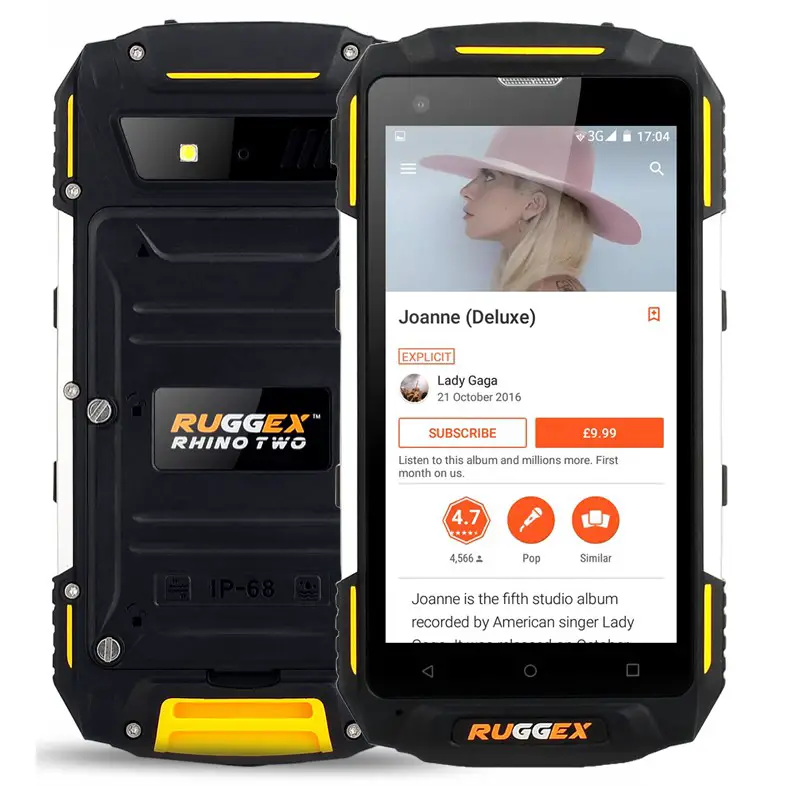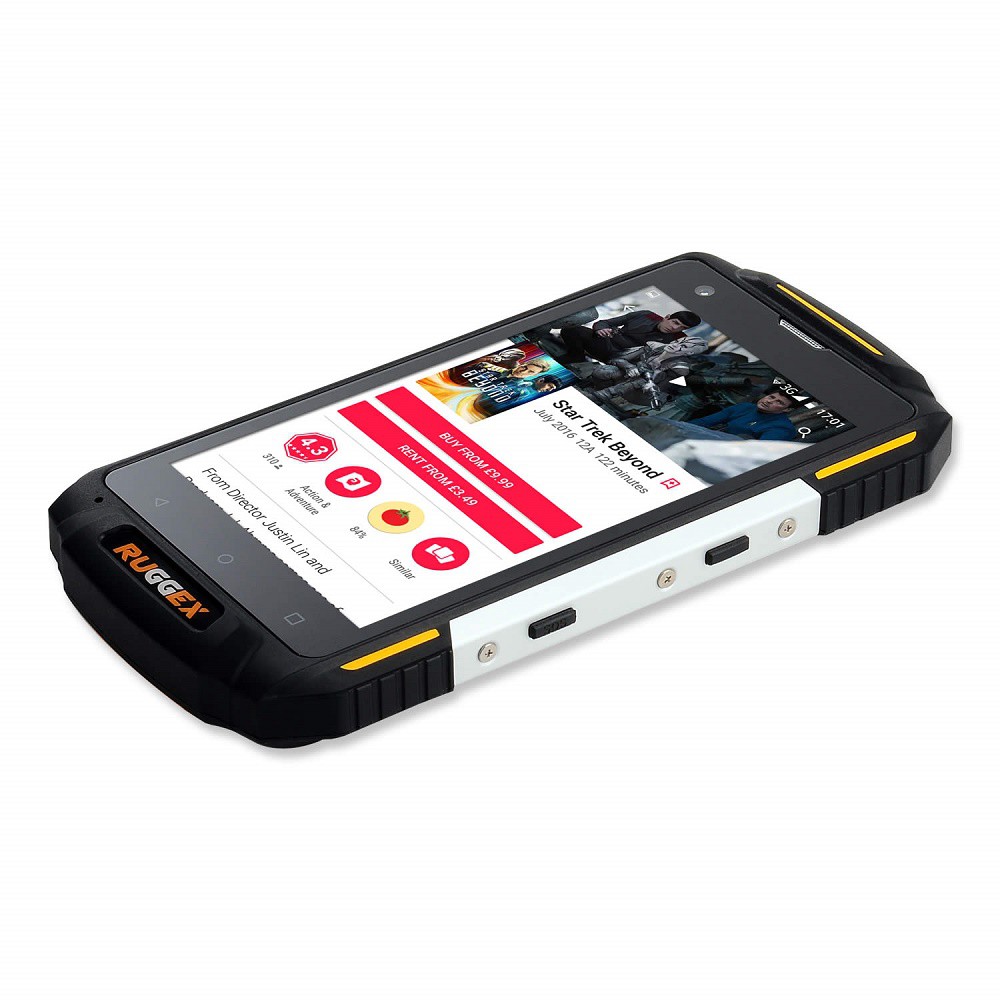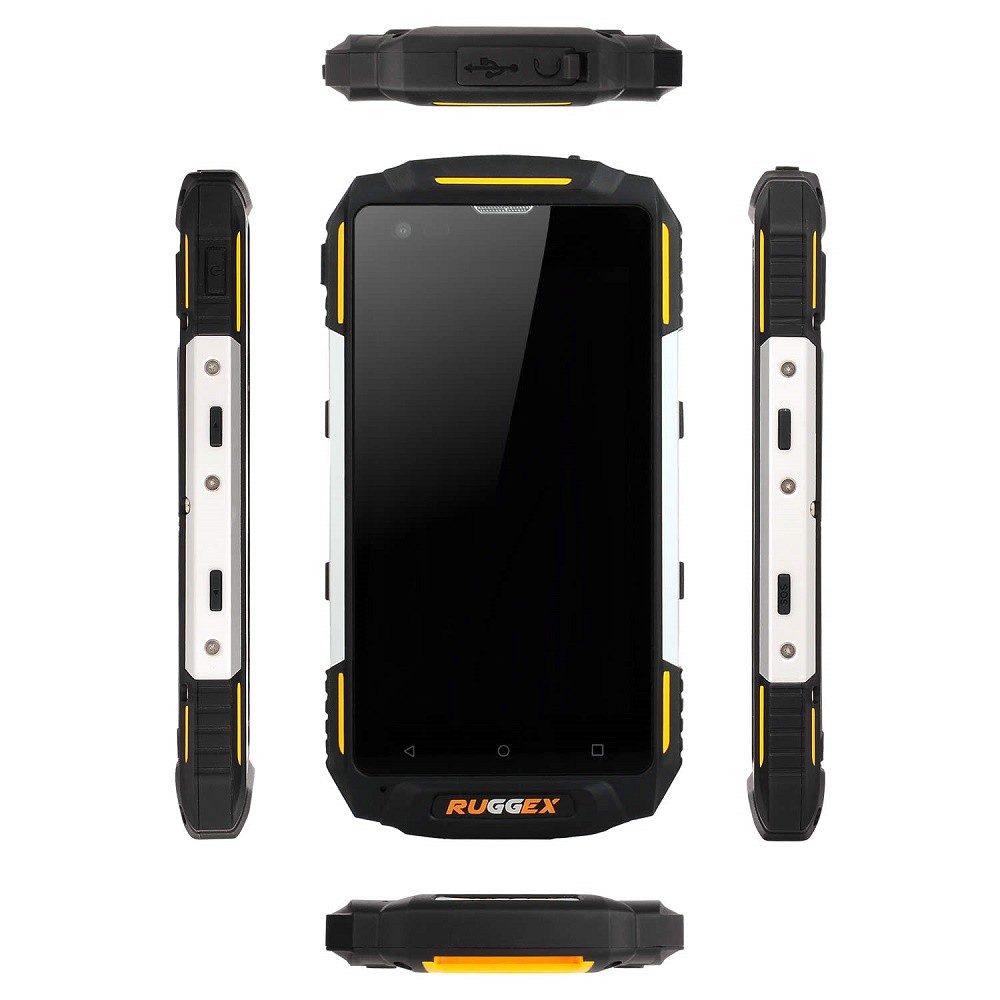






The Ruggex Rhino Two is a rugged smartphone with specifications very similar to the Ruggex Rugg5. Like both the Rugg3 and Rugg5, it is built for durability with an IP68 rating for dust and water resistance up to 1 meter for 60 minutes. It is also MIL-SPEC-810G certified to survive drops of up to 6 feet (1.8 meters).
The Rhino Two shares the same display size and resolution (4.5-inch IPS LCD, 540 x 960 pixels) as the Rugg5. It also comes with the same MediaTek MT6735 quad-core 1.3 GHz processor, 2GB of RAM, and 16GB of expandable storage (via microSD card, which takes up the second SIM card slot).
The camera system on the Rhino Two is identical to the Rugg5, featuring a 13MP single rear camera with PDAF and a 5MP front-facing camera without an LED flash. Both cameras can record videos in 720p resolution at 30 fps.
It comes with a slightly smaller removable battery (3100mAh compared to the Rugg5's 3500mAh) and has a slightly different color scheme (black with accents of silver and orange). It also runs on the same Google Android 5.1 (Lollipop) operating system.
| Launch This refers to the date when this device was officially introduced into the market. | Announced 2015, September / Released 2015, September |
| Brand / Model These are key identifiers that indicate the manufacturer or company that produces this smartphone, and the specific model of the phone. |
Ruggex / Rhino Two. - Also known as Ruggex Rhino2 |
| 2G Bands 2G refers to the second generation of cellular technology and includes various frequency bands for basic voice and text communication. | 850 / 900 / 1800 / 1900 - SIM 1 and SIM 2 |
| 3G Bands 3G refers to the third generation of cellular technology, encompassing different frequency ranges for faster data speeds, mobile internet, and multimedia capabilities. | 3G Bands 850 / 900 / 2100 |
| 4G Bands 4G refers to the fourth generation of cellular technology, operating in specific frequency bands to provide significantly faster data speeds, supporting high-definition video streaming and advanced applications. | LTE Band 1, 3, 7, 20 |
| Ruggedity This indicates the device's durability and ability to withstand harsh conditions or impacts. It is a very popular term used with tough or rugged phones. IP68/IP69K are international ratings that measure a smartphone's resistance to dust and water. MIL-STD-810H is a military standard that sets criteria for the environmental and durability testing of electronic devices. It means this device has undergone various tests to demonstrate its resilience in challenging conditions, such as extreme temperatures, humidity, vibration, and shock. |
IP68 / MIL-SPEC-810G - Water up to 1m for 60 mins / dust resistant / drop resistance up to 6ft |
| Dimensions / Weight: This refers to the physical size and weight of the device, measured in millimeter (mm) and grams (g) respectively. | 154 x 78 x 15 mm / 250 grams |
| SIM SIM stands for "Subscriber Identity Module." It is a small card, typically inserted into a slot in a mobile phone, that contains important information for connecting the device to a mobile network. SIM cards can come in various sizes, including standard SIM, micro SIM, nano SIM, or even electronic (eSIM), depending on the phone's design. | Hybrid Dual SIM (Nano-SIM, dual stand-by) |
| Screen Display refers to the screen or visual interface of the device. It includes details such as screen size, resolution, and technology (e.g., LCD, OLED, AMOLED). | 4.5-inches / IPS LCD touch screen |
| Resolution Screen Resolution refers to the number of pixels that make up the display screen and is typically expressed as a combination of horizontal and vertical pixel counts (e.g., 1920 x 1080, 2560 x 1440, or 3840 x 2160). The screen resolution determines the level of detail and sharpness of the visual content displayed on the smartphone's screen. Higher resolutions generally result in crisper and more detailed images and text | 540 x 960 pixels / 16:9 aspect ratio / 177 PPI |
| Features Camera features encompass various functionalities and capabilities that enhance the device's photography and videography experience. These features can include Optical Image Stabilization (OIS) Panorama, HDR, Ai Mode, Night Mode, Portrait Mode, etc. | Display protected with Corning Gorilla Glass 3 |
| OS This is the Operating System. It refers to the software platform that runs on the smartphone and manages the device's hardware and software resources. Common smartphone operating systems include Android (developed by Google), iOS (developed by Apple). | Google Android 5.1 (Lollipop) |
| Chipset This refers to the integrated circuit that serves as the device's central processing unit (CPU). It plays a pivotal role in the smartphone's performance, speed, and energy efficiency. |
MediaTek MT6735 - Quad-core 1.3GHz Cortex-53 - Mali T720 GPU |
| Memory This encompasses two components: storage capacity and RAM (Random Access Memory). Storage capacity, typically measured in gigabytes (GB) or terabytes (TB), dictates how much internal space is available for apps, files, and media storage. RAM, measured in gigabytes (GB), is temporary memory crucial for multitasking and app performance, with more RAM generally leading to smoother operation and faster task-switching capabilities. | 2GB RAM + 16GB ROM / SD-card support (uses SIM 2 slot) |
| Main The main camera, also known as the rear camera, is the primary camera on the back of the smartphone. It is typically used for capturing photos and videos in various scenarios and is often the more powerful and versatile camera on the device | 13MP single rear camera with PDAF |
| Selfie The selfie camera, also known as the front-facing camera, is the camera on the front of the smartphone, primarily used for capturing selfies and video calls | 5MP selfie camera (fixed focus), No LED flash |
| Features Camera features encompass various functionalities and capabilities that enhance the device's photography and videography experience. These features can include Optical Image Stabilization (OIS) Panorama, HDR, Ai Mode, Night Mode, Portrait Mode, etc. | Rear: 720p@30fps video recording / LED Flash |
| Connectivity This encompasses the device's ability to connect and communicate with other devices and networks. It includes features such as cellular connectivity, Wi-Fi, Bluetooth, NFC (Near Field Communication), and USB connectivity options. | NFC / Bluetooth 4.0 A2DP / WiFi (b/g/n) / FM Radio / Micro USB 2.0 |
| Navigation Navigation refers to the device's ability to determine and display location information and provide directions to users. This functionality is usually powered by Global Positioning System (GPS) technology. | A-GPS, GLONASS, BeiDou |
| Sensors This refers to the various built-in sensors that enable the device to gather information from its environment and interactions. Common sensors found in rugged smartphones may include fingerprint sensor, light sensor, barometer sensor among others. | Gravity, Light, Linear, Magnetic Field, Orientation, Proximity and Rotation |
| Battery This section refers to the device's power source and its related specifications. This typically includes details such as the battery capacity, measured in milliampere-hours (mAh) or watt-hours (Wh), and it charging details. | Li-Po 3100mAh, Removable |
| Others This is a catch-all category that includes various additional features, specifications, or capabilities that don't fall under the major categories like display, camera, memory, or connectivity. | Black with touch of Silver and Orange |
These specifications were entered manually, hence we CANNOT guarantee 100% accuracy. Also, that your device is listed on this website DOES NOT call for reckless usage! It is crucial to exercise due diligence, as we cannot be held responsible for any damage to your device due to overconfidence in it built quality.
Leave a Reply